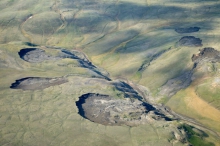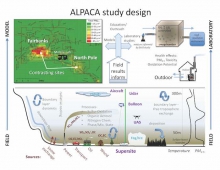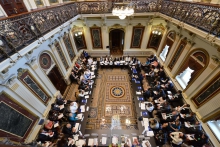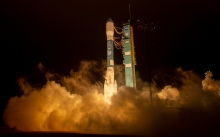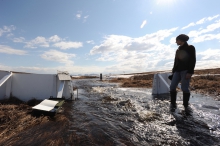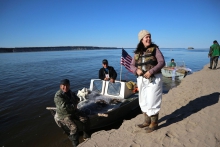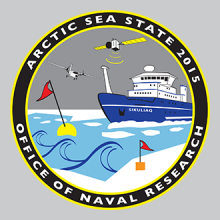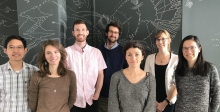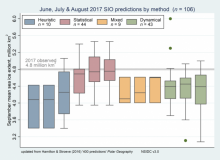Witness Community Highlights is an online publication launched in May 2017 to complement the regular publications of Witness the Arctic. It was developed in response to community feedback identifying the need for a monthly publication to highlight 1–2 Arctic research efforts and other timely items of interest to our readers. Community Highlights is distributed monthly via our Witness the Arctic mailing list of over 8,600 subscribers.
A New and Exciting Age in Polar Science
"We are embarked on a new and exciting age in polar science; NSF, I am proud to say, is solidly committed to keeping the U.S. at the forefront of this new era ... It is clear today that changes in the polar regions affect the rest of the globe, and the need to understand and try to predict and even remediate those changes, has become a national and international priority." - Kelly K. Falkner, Director of the Office of Polar Programs, NSF
By: Kelly K. Falkner, Director of the Office of Polar Programs, National Science Foundation
Editor's note: This article was excerpted from a piece that originally appeared on 27 March 2019 in the journal Open Access Government.
Comparative Study Explores Northern Dene Astronomical Knowledge
The sky is routinely overlooked in Northern Dene (Athabaskan) ethnology as a meaningful site for investigating linguistic and cultural knowledge. The central research question of this study asked: How do Northern Dene peoples perceive, conceptualize, and integrate the sky and its contents into systems of knowledge and worldview? Results have shown that systems of stellar knowledge are especially complex and detailed.
By: Chris Cannon, Ph.D. student in Cultural Anthropology at the University of Alaska Fairbanks
A Remarkable Response of Ice-Rich Permafrost Terrain to Summer Warming
Thaw of permafrost containing high concentrations of ground ice can dramatically impact Arctic environments through resulting thermokarst features. Once exposed to melt, retrogressive thaw slumps, the most important type of thermokarst landform on sloping terrain, may reactivate every summer for up to 50 years—altering water quality and aquatic ecosystems, and liberating frozen organic carbon for subsequent decomposition, thereby contributing to the permafrost carbon feedback.
By: Antoni Lewkowicz, Department of Geography, Environment, and Geomatics at the University of Ottawa
Alaska NSF Program Releases Stakeholder Engagement Report
A recent study by Alaska NSF Established Program to Stimulate Competitive Research (EPSCoR) examined the capacity of different Northern communities to adapt to change. A key element of the project was directly engaging with community stakeholders to help shape the direction of the research, and to ensure that research outcomes met local needs. The subsequent report, "Sharing Questions, Sharing Answers" details strategies used by different parts of the project to engage stakeholders, and lessons learned along the way.
By: Tom Moran, Alaska NSF EPSCoR, Communications Manager
Novel Project Seeks Understanding of Air Pollution Processes in Arctic Conditions
Pollution in Arctic cities and near industrial areas can be quite severe and wintertime Arctic conditions differ greatly from the more-studied pollution problems during summertime in the more populated mid-latitude regions. The Alaskan Layered Pollution And Chemical Analysis (ALPACA) project seeks to close knowledge gaps in understanding of atmospheric chemical mechanisms occurring under cold and dark conditions.
By: William R. Simpson, Geophysical Institute and Department of Chemistry and Biochemistry, University of Alaska Fairbanks
2018 Arctic Observing Summit Meeting News
Members of the Arctic Observing Summit—Working Group on Implementation and Optimization met recently to gather input for a draft Task Team Scope of Work supporting Sustaining Arctic Observing Network—Committee on Networks objectives. The draft task statement addresses several areas, including how to develop a process that will generate strong international investments in Arctic observing and promote synergies and interoperability among observing efforts.
By: Sandy Starkweather, Executive Director of the U.S. Arctic Observing Network
Revised Principles for Conducting Research in the Arctic: 21st Century Guidelines to Ethical Research
The U.S. Interagency Arctic Research Policy Committee has completed the revision of the Principles for Conducting Research in the Arctic. These Principles provide guidelines for researchers to engage with people and conduct research in the Arctic. They cover a range of topics from creating a safe work environment, crediting and compensating collaborators, coordinating with local communities, learning about the history and culture of the region, data ownership, and limiting environmental impact.
By: Renee Crain Wagner, Arctic Research Support and Logistics (RSL) Program Manager at NSF; Amina Schartup, AAAS Science & Technology Policy Fellow hosted in the NSF Office of Polar Programs, Arctic Sciences Section; and Meredith LaValley, IARPC.
NOAA Arctic Report Card 2018: Brief Summary
The Arctic Report Card 2018, released on 11 December 2018, describes a range of land, ice, and ocean observations made throughout the Arctic. The report includes 14 essays written by more than 80 scientists from 12 countries. The collective content of the report makes clear that the continued warming of the Arctic atmosphere and ocean are driving broad change in the environmental system in predicted, and also unexpected, ways. The results reported show that the effects of persistent Arctic warming continue to mount.
By: Emily Osborne, National Oceanic and Atmospheric Administration, Arctic Research Program; Jacqueline Richter-Menge, University of Alaska Fairbanks, Institute of Northern Engineering; Martin Jeffries, Cold Regions Research and Engineering Laboratory of the Engineer Research and Development Center, U.S. Army Corps of Engineers
Arctic Science Ministerials: High Level Political and Policy Support for Grass Roots Level International Scientific Collaboration
The socio-ecological consequences of changes in the Arctic environmental system extend far beyond the Arctic, and international collaboration is essential to address the challenges arising from a warming Arctic. Scientists are very effective in international scientific collaboration, developing research-driven joint projects and programs from the bottom up. The Arctic Science Ministerials, where governments of Arctic and non-Arctic states are making commitments that provide high-level political and policy support for the scientists' grass-roots efforts, are an important addition to the landscape of Arctic scientific collaboration and the development of Arctic science diplomacy.
By: Martin O. Jeffries, PhD, Cold Regions Research and Engineering Laboratory (CRREL), Engineer Research and Development Center, U.S. Army Corps of Engineers, Hanover, New Hampshire
NSF's Navigating the New Arctic (NNA)
Navigating the New Arctic, one of NSF's 10 Big Ideas, embodies the Foundation's forward-looking response to the profound challenges associated with the Arctic. The solicitation tackles scientific challenges in the rapidly changing Arctic and seeks innovations in Arctic observational networks and fundamental convergence research across the social, natural, environmental, computing and information sciences, and engineering that address the intersection of natural, social, and built systems. The most competitive proposals will include expertise from multiple traditionally distinct and independent science and engineering disciplines.
By: Roberto Delgado Program Director, Arctic Observing Network, Section for Arctic Sciences, Office of Polar Programs, National Science Foundation
A New Season for Sea Ice and Walrus
Unusually low Arctic sea ice conditions in the winter of 2017 brought to the forefront questions about what the impacts of low sea ice would mean for the communities and ecosystems in the Bering Sea.
The Sea Ice for Walrus Outlook (SIWO) program, a long-term collaborative effort between academic and federal researchers, ARCUS, the Eskimo Walrus Commission, and coastal subsistence hunters in the Bering Strait region, was poised to provide some answers about how Pacific walruses migrating north in spring might respond to low ice conditions.
By: Olivia Lee, Assistant Research Professor, International Arctic Research Center, University of Alaska Fairbanks.
Co-Production of Knowledge and Multi-Level Governmental Collaboration in A Rapidly Changing Arctic
The Arctic is in the midst of an unprecedented environmental transition caused by increasing land and ocean temperatures. Arctic sea ice is rapidly decreasing and, with little sea ice, Alaska Native coastal communities have limited protection from storm surges. In the United States, no institutional framework currently exists to determine whether and when relocation needs to occur in order to protect people from environmental hazards. Inspired by usteq, the Yup'ik word for catastrophic land collapse, the Alaska Institute for Justice is working with 15 Alaska Native communities to address this institutional gap.
By: Robin Bronen, JD, PhD, Executive Director the Alaska Institute for Justice and Denise Pollock, Research Director at the Alaska Institute for Justice
Unique Fellowship Program Promotes Community Interaction
Funded by the National Science Foundation, the Sitka Sound Science Center's Scientist in Residency Fellowship (SIRF) program is designed to help communities learn about polar research and broaden participation in Science, Technology, Engineering, and Mathematics (STEM) disciplines. The Fellowship facilitates community engagement activities for polar scientists and provides time for them to work. Capitalizing on the kind of casual way that people in Alaskan rural communities have of getting to know people is what makes the SIRF model unique.
By: Lisa Busch, Executive Director, Sitka Sound Science Center
2018 Arctic Sea Ice Minimum Extent Reached in Late September
According to the recently published Sea Ice Outlook 2018 Interim Post-Season Report, the 2018 Arctic summer melt season official ended on 14 September. The September monthly averaged sea ice extent was 4.71 million square kilometers, based on the National Snow and Ice Data Center (NSIDC) Sea Ice Index. This ranks as effectively tied with 2008 for the 6th lowest in the satellite record that began in 1979.
This article is adapted from the 2018: Sea Ice Outlook Interim Post-Season Report.
ICESat-2 Launches to Measure Earth's Ice
The National Aeronautics and Space Administration's (NASA) Ice, Cloud and Land Elevation Satellite-2 (ICESat-2) launched from Vandenberg Air Force Base in California on 15 September 2018. The ICESat-2 mission, managed by NASA's Goddard Space Flight Center, will measure the changing height of Earth's ice using the Advanced Topographic Laser Altimeter System (ATLAS), which measures height by timing how long it takes individual laser photons to travel from the spacecraft to Earth and back, with a precision of better than a billionth of a second. With this and other technological advancements of ICESat-2, scientists will be able to provide new insights into how the polar regions are changing with global temperature rise.
By: Kate Ramsayer and Nathan Kurtz, NASA Goddard Space Flight Center
Highlighting the Stories and People Behind Preserved Arctic Data
The Arctic Data Center has recently established a Dataset Highlights page. The Dataset Highlights page provides insights directly from the researchers, including how their data might be applied to other questions in support of Arctic research. The six datasets highlighted here are from studies of Arctic soil bacteria, Arctic river geochemistry, Indigenous subsistence harvest, local community response to ecosystem change in the Bering Sea, the habitability of fragile rotten ice, and phenological mismatch in the Arctic.
By: Kathryn Meyer, Community Engagement and Outreach Coordinator at the Arctic Data Center
News from the National Science Foundation
The National Science Foundation (NSF) welcomes new staff to the Arctic Sciences Section including Program Directors Colleen Strawhacker, Arctic Social Sciences and Arctic Systems Science; Gregory J. Anderson, Arctic Systems Sciences; and Roberto Delgado, Arctic Observing Network. Brief introductions to Program Directors Colleen Strawhacker and Roberto Delgado are highlighted in this article. The NSF announcement of new measures to protect the research community from harassment is also included in this article.
Results and Highlights from the "Sea State and Boundary Layer Physics of the Emerging Arctic" Program
A recent program funded by the Office of Naval Research has focused on the sea state and boundary layer physics of the emerging Arctic, which is defined by less sea ice and larger expanses of open water in summer. After developing a climatology of the sea state in the region, the program planned and executed a 42-day field measurement campaign on the R/V Sikuliaq during the autumn of 2015. A key observation of the prevalence of pancake ice indicates that surface waves are having a significant effect on sea ice formation in the region. Along with the field campaign, the program developed and applied models for wave-ice interactions as well as models for air-ice-ocean interactions, which were tested and improved with the field data.
By: Jim Thomson, Applied Physics Laboratory, University of Washington
Community-Driven Sea Ice Modeling with the CICE Consortium
CICE, also known as the Community Ice CodE and the Los Alamos Sea Ice Model, is a computer code developed to support modelling of the physical processes associated with sea ice evolution. Today, the CICE sea ice model is used in more than 20 countries for applications as diverse as global climate projections, research into fundamental sea ice processes, daily sea ice and weather forecasting, and special missions such as NASA Operation IceBridge flights and the Navy's 2018 ICEX Camp. The CICE Consortium aims to incorporate and maintain scientific sea ice model development in CICE for the community, accelerating its transfer into operational applications.
By: Alice K. DuVivier, Associate Scientist, Climate and Global Dynamics Laboratory, National Center for Atmospheric Research; and Elizabeth C. Hunke, Deputy Group Leader, T-3 Fluid Dynamics and Solid Mechanics Group, Los Alamos National Laboratory
Adaptive Management of Freshwater Ecosystems in the Arctic
In 2012, the Arctic Landscape Conservation Cooperative provided support for teams of interdisciplinary scientists to address habitat and species’ responses to climate change in Arctic Alaska. The Fish CAFE team, in response to the call, developed research to address those questions in the focal watershed of Fish Creek, Alaska. The science outcomes are part of an ongoing adaptive management process that is essential to sound decision making in the NPR-A and can serve as a model for other Arctic regions facing climate and land-use uncertainty.
By Chris Arp and Vladimir Alexeev, University of Alaska Fairbanks; Benjamin Jones, U.S. Geological Survey; Matthew Whitman, Stacey Fritz, Deb Nigro, Bureau of Land Management; Hannah Uher-Koch, University of Alaska Anchorage; and Ronnie Daanen, Alaska Department of Natural Resources
Building the Arctic Data Center Community
Since 2016, the Arctic Data Center has supported the curation and preservation of Arctic research data. Currently, the Center hosts about 5000 datasets representing over 650,000 files, and the size of data holdings has quintupled during the past two years to over 20 terabytes today. The Center's software developers and data support team continue the ongoing curation of Arctic data and building of efficient data management and discovery tools. At the same time, the outreach and training team is ramping up community engagement with new activities, including Data Science Fellowships and training events, throughout the coming year.
By: Kathryn Meyer Community Engagement & Outreach Coordinator, Arctic Data Center; Vanessa Raymond, Training and Outreach Coordinator, Arctic Data Center; Amber Budden, DataONE, Co-Principal Investigator Arctic Data Center; Matthew Jones, National Center for Ecological Analysis and Synthesis (NCEAS), Principal Investigator Arctic Data Center
Engaging a New Generation of Arctic Researchers: Lessons Learned from 15 Years of Summer Programs
Since 2003, the International Arctic Research Center (IARC) has organized NSF-supported summer schools for students and early career scientists. These programs provide students with the current state of knowledge, hands-on training in conducting Arctic research, and the skills necessary to communicate science across disciplines. Experts from a range of Arctic disciplines introduce the cutting-edge science in their research areas through lectures, model-based experimentation, and field excursions. Students are guided in group projects that encourage participants to explore the intersections between traditional disciplines. An international component of the summer school provides perspectives and international collaboration— key elements of future Arctic research. Building on the knowledge gained during 15 years has led to success and innovation in the summer school program.
By: Vladimir A. Alexeev, International Arctic Research Center, University of Alaska Fairbanks; John E. Walsh, International Arctic Research Center, University of Alaska Fairbanks; Danica J. Loucks, Department of Anthropology, University of California Irvine; Regine Hock, Geophysical Institute, University of Alaska Fairbanks; and Ute Kaden, School of Education, University of Alaska Fairbanks
NSF's Sikuliaq Joins a New Arctic Research Icebreaker Consortium
The University of Alaska Fairbanks (UAF) and the research vessel Sikuliaq will join partners from Europe and Canada in the newly formed Arctic Research Icebreaker Consortium (ARICE). This new international consortium, consisting of 15 partners from 13 different countries, will support planning and implementation of Arctic research cruises by better coordinating the existing icebreaker fleet, allowing researchers to compete for fully-funded ship time, and collaborating with commercial vessels to increase Arctic data collection. For the first time, scientists conducting research in the Arctic Ocean will be able to apply for fully funded access to six international icebreakers, including Sikuliaq. While cruise time will be granted to researchers based on merit, ARICE project coordinators hope the program will increase opportunities for early career researchers and scientists from countries who do not have easy access to an icebreaker.
By: Lauren Frish, Public Information Officer, Sikuliaq Science Liaison, College of Fisheries and Ocean Sciences, University of Alaska Fairbanks
Arctic Sea Ice Conditions and Predictions from the 2017 Sea Ice Outlook Post-Season Report
The Sea Ice Outlook (SIO), an activity of the Sea Ice Prediction Network (SIPN), provides an open forum for researchers and others to develop, share, and discuss seasonal Arctic sea ice predictions. The SIO produces reports in June, July, and August containing a variety of perspectives on Arctic sea ice—from observations of current conditions, to advanced numerical models, to qualitative perspectives from citizen scientists. A post-season report provides an in-depth analysis of factors driving sea ice extent in the summer and explores the scientific methods for predicting Arctic sea ice. Key highlights from the SIO 2017 Post-Season Report, released earlier this month, include discussion of 2017 Arctic weather and ice conditions; the Outlook contributions and methodologies, including regional forecasts; and sea ice extent probability maps. The report also includes discussion of contributions for forecasts of the Antarctic maxima through the "SIPN South" project.
By: Julienne Stroeve, NSIDC; Cecilia Bitz, U. Washington; Walt Meier, NSIDC; Edward Blanchard-Wrigglesworth, U. Washington; James Overland, NOAA/U. Washington; Muyin Wang, NOAA/U. Washington; Hajo Eicken, International Arctic Research Center; Lawrence Hamilton, U. New Hampshire; Jenny Hutchings, Oregon State U.; Helen Wiggins, ARCUS; Adrienne Tivy, National Research Council of Canada; Philip Jones, Los Alamos National Laboratory; and Elizabeth Hunke, Los Alamos National Laboratory
The Leadership and Strength Project in Utqiaġvik, Alaska
Indigenous values, cosmologies, and frameworks are critical to the future of conservation, natural resource management, and climate change sciences. These are pillars from which to craft researcher-community relationships that have specific policy outcomes that support pursuits of sovereignty and self-determination.The Leadership and Strength project, which began in 2009, is a decade-long process of collaboration with local advisors and community members in Utqiaġvik, Alaska (formerly known as Barrow). This project draws upon engaged community-based research approaches to examine community strength and well-being and to focus on the pathways that women, men, and families forge to live well in Utqiaġvik. The stories shared as part of this work discussed historical legacies in the community that were sources of trauma as well as positive stories of community leadership and strength.
By: Dr. Laura Zanotti, Associate Professor of Anthropology, Purdue University; Dr. Courtney Carothers, Associate Professor of Fisheries, University of Alaska Fairbanks




